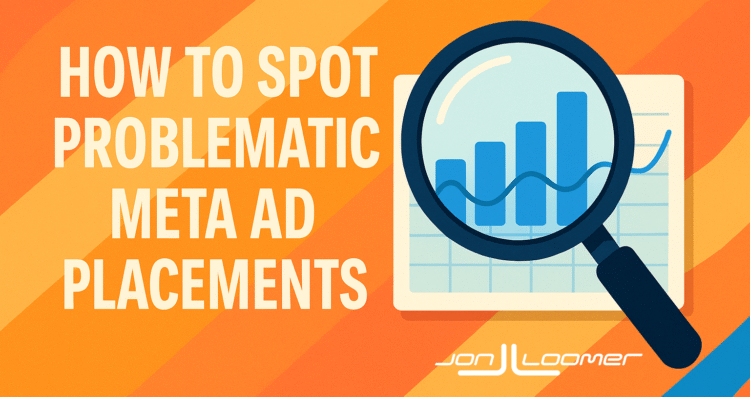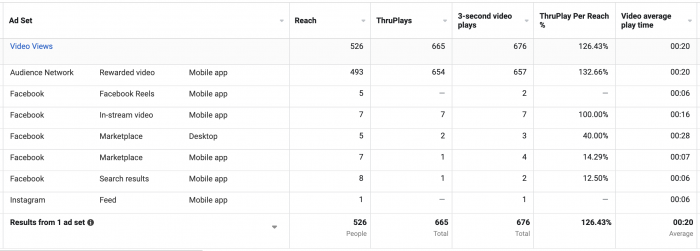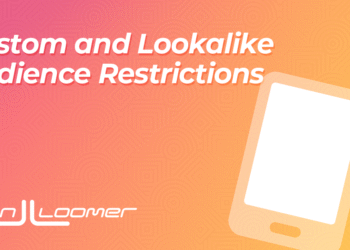Experienced advertisers know all about the pitfalls of problematic Meta ads placements. Unfortunately, inexperienced advertisers are prone to waste countless ad dollars before learning this valuable lesson.
Of course, the answer isn’t as simple as saying, “Never use X placement.” It’s a carelessly aggressive way to solve a problem that may make your results worse. And it shows a lack of understanding of how things work.
No placement is universally problematic. Advertisers need to understand the context that can make a placement problematic in the first place.
That’s the purpose of this post. I want you to understand how placements can become problematic so that you’re able to quickly diagnose problems before wasting ad dollars.
In this post, we’ll cover the following:
- What makes a Meta ad placement problematic
- How to diagnose problematic Meta ad placements
- Specific examples of problematic placements
- A smarter approach to Meta ad placements
What Makes a Meta Ad Placement Problematic
What makes a Meta ad placement problematic isn’t the bad results. In fact, it’s the complete opposite. If a placement provides no value toward accomplishing your performance goal, it’s unlikely to be utilized much, if at all.
A placement becomes problematic because it produces a high volume of low-quality, misleading results.
It’s critical that you understand why this is the case. The algorithm, in its role to get you the most results, will leverage various signals to make you happy. The signals the algorithm cares about change depending on the performance goal.
The performance goal is an important component of this issue. If a placement is a known source of the specific action you are looking for, it will be leveraged heavily to get you that action.
This is most common with top-of-funnel actions like clicks and video views. Since the algorithm is literal, Meta’s only care is that you get the action that you say you want, as defined by your performance goal. While you actually care that those actions are high-quality and meaningful, Meta doesn’t.
We can summarize the components of a problematic placement like this…
1. The placement is a known source of a specific type of cheap action.
2. You define a performance goal that matches the action that the placement can produce inexpensively.
3. The actions are both cheap and low-quality. This is usually related to how the placement itself works that it can generate this action at a high volume.
The truth of the matter is that a placement wouldn’t necessarily be problematic because it produces a high volume of the cheap actions that you want. The problem happens if and when those actions are low quality.
Unfortunately, results that appear too good to be true almost always are.
How to Diagnose Problematic Meta Ad Placements
The first sign of a problematic placement is one that is the easiest for advertisers to ignore: Results that seem too good to be true.
You don’t want to question these results. You think that you’ve found the magical solution. The ads you created are freaking amazing.
But once you get over that feeling, do yourself a favor and use the Breakdown feature to view your results by placement.
The Breakdown dropdown menu is found between the Columns and Reports menus in Ads Manager.
Placement is found within Delivery.
Meta will then generate a separate row for each placement used.
It’s easy to misunderstand the purpose of this breakdown and head down the wrong path. What I don’t want you to do is pick it apart to isolate the top and bottom performers to then turn off certain placements in an attempt to optimize performance. You’re not searching for wasted budget on low-performing placements.
Instead, you should do the opposite. Look to see if a high percentage of your budget is getting spent on a placement that is generating a high volume of cheap results. That is your red flag.
If you see a high concentration of budget going to a placement, ask yourself these questions:
- How does this placement work?
- What is it about this placement that would produce this action so cheaply?
- What could make these actions misleading or low quality?
I’ve found this to be an excellent resource to help understand how each placement works. It’s what helped me flag the placements listed in this post below.
Example #1: Audience Network Native, Banner, and Interstitials
About This Placement
Here’s how Meta defines it:
Audience Network brings the power of Facebook audience targeting to additional websites and mobile apps, giving marketers even more scale for their Facebook campaigns. Using Audience Network allows you to extend your ad campaigns beyond Facebook to reach people with native, banner and interstitial ads.
Audience Network is unique because, unlike the vast majority of placements that showcase your ads within Meta’s family of apps, Audience Network is a network of non-Meta apps. These apps, which are typically free, monetize themselves with ad placements.
Performance Goal
There are two performance goals that can lead to problems with this placement:
- Maximize number of link clicks
- Maximize number of landing page views
It does not matter whether you use the Traffic, Sales, or any other campaign objective. The problem will be the same because delivery of your ads is controlled by the performance goal.
The Unique Problem
I first spotted this problem years ago while playing Trivia Crack, which is a third-party app monetized with ads from Audience Network. While playing, my own ad popped up unexpectedly, and I clicked it accidentally.
That experience helped me experience one of the key potential problems with Audience Network: Accidental clicks. But that’s not the only issue.
Possibly the bigger issue is click fraud. Since Meta has less control over the environment where these ads are displayed, they are likely more prone to bot activity and malicious clicks than Meta’s own family of apps.
Meta knows about this problem, of course. In fact, you’ve likely received a modest refund at some point (if not many times) after Meta discovers fraudulent clicks. It’s good that Meta gives us our money back when this happens, but the problem is that the damage was already done since the algorithm was fooled by those fraudulent clicks.
If you choose a performance goal that maximizes link clicks or landing page views, perform a breakdown by placement. There is a very high likelihood that a large percentage of your budget is getting spent on this placement. And it’s also likely that you’re getting very cheap results.
Why it Matters
This is where so many inexperienced advertisers can be fooled. They may not have the pixel, API, and conversion events set up fully, so they run ads prioritizing traffic. When they do that, they assume the traffic they get is from people who actually care about their product or content.
Unfortunately, Audience Network notoriously produces empty traffic. Double check your website reporting to get a sense of the activity generated after the click. You want long visits, deep engagement, and conversions.
Instead, you’re likely to discover Audience Network traffic is made up primarily of short visits, if not immediate abandons. That will rarely be beneficial, which would drastically alter your interpretation of results.
You’ll likely regret the ad spend and choose to remove the placement when using these performance goals.
Example #2: Audience Network Rewarded Video
About This Placement
Here’s how Meta defines it:
Rewarded video ads are a fullscreen experience where users opt-in to view a video ad in exchange for something of value, such as virtual currency, in-app items, exclusive content, and more.
As was the case with the first placement, Rewarded Video is part of the Audience Network. In other words, third-party app developers use this placement to monetize their apps.
What makes this unique compared to the other Audience Network placement is that Rewarded Video “rewards” or “incentivizes” views. Your target audience is using a third-party app, likely for free, and can unlock virtual currency and other in-app items by watching an ad.
Performance Goal
This placement is most problematic for maximizing ThruPlay views, but it’s also possible, if not likely, to be an issue for 2-second continuous video plays.
The Unique Problem
I first spotted this problem a few years ago when I decided to commit to publishing short-form video content. In an effort to give it a push, I put some advertising budget behind it.
Well, I ran into some numbers that were too good to be true.
Now, I felt pretty good about my videos. But I was getting more ThruPlays than people reached. A ThruPlay requires that people watch at least 15 seconds of my videos (these videos were all a minute long).
And that, I knew, was simply impossible. There is no way that my videos were so good that everyone chose to watch them for at least 15 seconds, with some choosing to watch multiple times.
So I performed a breakdown by placement and found our culprit…
A ridiculous 98% of my ThruPlay views came from Audience Network Rewarded Video. And people were watching for an average of 20 seconds.
Why was this happening? Well, it’s easy to explain when you understand how this placement works.
My target audience was playing a game on a third-party app. That app requires virtual currency that can be used to level up your place in the game. You could pay for that virtual currency or perform certain approved actions instead, like watching a video. And that’s where my ads came into play.
These people watched for 20 seconds per view, but they didn’t care about my video. They weren’t inspired by my production quality or message. They played the video (likely didn’t actually watch or pay attention) to get something in exchange.
This was also reflected in the fact that despite the very high number of ThruPlay views, my videos generated very few clicks to my website.
Why it Matters
This is once again about knowing what you are paying for. Most advertisers who run ads that maximize ThruPlay views assume that their results reflect people who actually cared about their video or product. But if it’s a view from Audience Network Rewarded Video, that’s unlikely to be the case.
Meta used this placement to get you more of the action that you wanted, but you also likely wanted people who were actually inspired by your video. And if that’s what you actually wanted, this placement is not your solution.
Like all of these placements, whether these low-quality results are acceptable to you comes down to knowledge and context. If you know what you’re getting and you’re able to prove that the results are worthwhile, great.
But most people are going to be blinded by the results and assume they’re getting something they’re not.
Example #3: Ads on Facebook Reels
About This Placement
There are two versions of Ads on Facebook Reels, depending on the format.
For static image, this is how Meta defines it:
Overlay ads is a form of Ads on Facebook Reels that render on Reels content in the form of a single, static image ad. Overlay ads can appear at the start of the Facebook Reel content and can appear as a banner at the bottom of the reel or as a sticker towards the top.
And for video ads:
Facebook Reels Post-Loop Ads is a form of Ads on Facebook Reels that render on Reels content in the form of a four second or longer video ad that can appear after a Facebook Reel has looped.
Here’s an example that Meta shares when editing placements in Ads Manager…
The “ad” isn’t the Reel itself. It’s the bar at the bottom of the Reel that the user was watching.
Performance Goal
I’ve seen this when using the performance goal to maximize reach, but it’s also likely to impact similar performance goals that don’t require an action, like impressions.
While Ad Recall Lift is likely a bit safer, it all depends on how Meta is measuring that lift.
The Unique Problem
I stumbled on this randomly recently while running an experiment using an Awareness campaign to promote content. I was only targeting the US, but I immediately noticed an insanely low CPM of 22 cents. While I’d expect lower CPMs, this certainly fell into the “too good to be true” category.
I used breakdown by placement and discovered that 99% of my impressions went to Ads on Facebook Reels.
When such a heavy distribution happens for a single placement, you have to immediately ask why that would be the case. What is it about this placement that would make it ideal for accomplishing the performance goal of reach?
My theory here is that there are two things about this placement that make it unique:
- Very high inventory because of volume of Reels
- The placement is ineffective at achieving anything else
For almost all placements, your ad is the star. Think about the feeds, stories, and Reels placements. Your ad is the primary content.
That’s not the case for Ads on Facebook Reels. Your ad is at the very bottom of a video that someone is watching. It’s static, and not dynamic. It takes up very little real estate. And if anything, it could be an annoyance because it might cover up important text on the Reel that someone is watching (which may also lead to accidental clicks, but that’s irrelevant here).
Because of these factors, Ads on Facebook Reels is very unlikely to be a major driver of conversions or any deep engagement. Combined with the high volume of Reels in the inventory, that makes it very easy for Meta to find cheap impressions with minimal competition. It creates an opportunity to leverage this placement for the lowest barrier actions possible.
This is likely why the Ads on Facebook Reels placement is so cheap, and why it’s the perfect fit for this performance goal.
Why it Matters
On the surface, you can make the argument that Ads on Facebook Reels creates a great opportunity to generate awareness very inexpensively. As long as you know where your spend is going, it’s an experiment worth trying.
But when most advertisers run ads for the purpose of awareness, they assume their ads will actually be seen. They envision their ads appearing in feeds, stories, or as the star Reel. This is far from that.
I’ve found that the cost to reach people using Ads on Facebook Reels is about 10% of the cost of those other main placements when optimizing for reach. Maybe you’ll find that tradeoff worthwhile. I have my doubts.
A Smarter Approach to Meta Ad Placements
As I said at the top, it would be easy to apply a blanket approach to problematic placements. Why not just remove them for all performance goals?
While you could, it shows a general misunderstanding of how Meta’s ad delivery algorithm works.
Meta is automatically and constantly balancing costs and effectiveness to help you get the most results within your budget. While that can lead to problems when a placement’s low-quality results align with your performance goal, it is unlikely to be an issue otherwise.
For example, when using the performance goal of maximizing the number or value of conversions (especially when that conversion is a purchase), you’re likely to find that Audience Network is rarely used at all. The algorithm knows that cheap clicks are unlikely to lead to the action that you want.
While removing Audience Network universally may not matter much in the grand scheme of themes, it’s also unnecessary. Editing placements turns Advantage+ off, which is an adjustment that should be the exception rather than the rule. It might increase your costs, rather than improve performance.
In other words, prioritize using Advantage+ Placements. Only manually remove a placement if you know that it leads to low-quality results that match your performance goal. Be able to explain why a placement leads to low-quality results and wasted budget. Such a move from the default should only be made to solve a problem, rather than applying a blanket approach.
Your Turn
I’ve found that you should normally remove these placements in specific situations because they lead to low-quality results that reflect your performance goal. There may be other examples.
What other placements do you remove, when do you remove them, and what is unique about that performance goal for that situation?
Let me know in the comments below!























